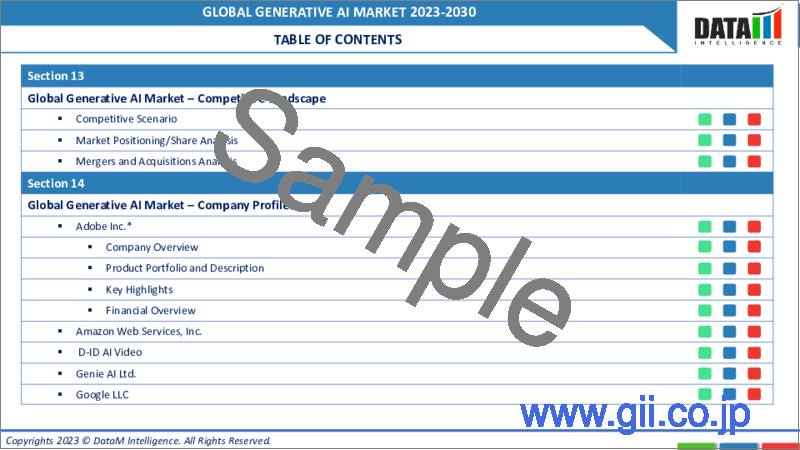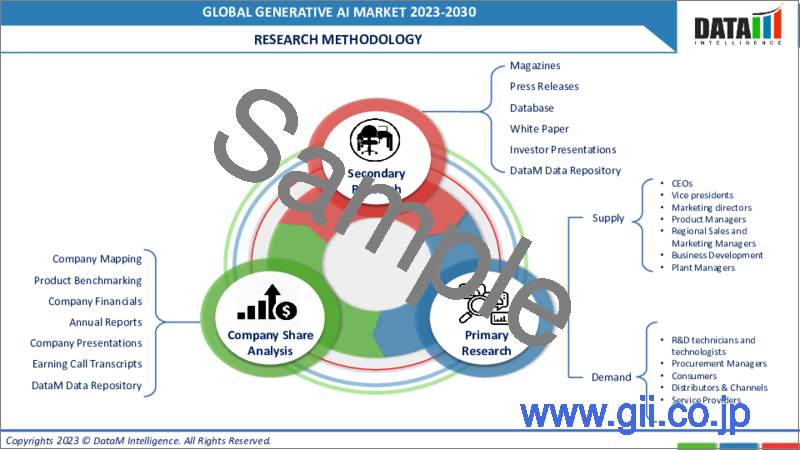|
|
市場調査レポート
商品コード
1336687
生成AIの世界市場-2023年~2030年Global Generative AI Market - 2023-2030 |
||||||
カスタマイズ可能
適宜更新あり
|
|||||||
| 生成AIの世界市場-2023年~2030年 |
|
出版日: 2023年08月22日
発行: DataM Intelligence
ページ情報: 英文 205 Pages
納期: 即日から翌営業日
|
- 全表示
- 概要
- 目次
市場概要
生成AIの世界市場は、2022年に111億米ドルに達し、2023年から2030年の予測期間中にCAGR 35.7%で成長し、2030年には526億米ドルに達すると予測されています。生成AIによってシステムは多機能化し、画像やテキストなど複数の形態を同時に解釈できるようになるため、利用領域が広がり、汎用性が高まります。生成AIは、人間がプログラミング言語の代わりに自然言語を使ってコンピュータと会話できるようにすることで、人間とコンピュータのインタラクションを向上させます。
市場の推計・予測期間中、メディア・エンターテインメントカテゴリーは世界市場の約1/3を占めると推定されます。より優れた商業キャンペーンを作成するために生成AIの利用が増加していることが、メディアおよびエンターテインメント業界における市場需要を促進すると予想されます。米国を拠点とするインターネットメディア、ニュース、エンターテインメント企業であるBuzzFeed社は、2023年1月に、特定のコンテンツ提供を強化しパーソナライズするために、米国のAI企業であるOpen AI社が提供するAI機能を使用すると表明しました。
市場力学
AI導入の増加
超解像、テキストから画像への変換、テキストから動画への変換のような革新的なソリューションの利用が増加していることに加え、業界全体でワークフローの近代化に対する需要が高まっていることから、エンターテインメント、医療、エンジニアリング、金融、防衛などの業界で生成AIの需要が高まっています。さらに、AIの利用が増加しているのは、処理能力が向上し、幅広い産業分野の困難に対処できるようになったためです。
同様に、生成AIは、画像処理や映画の修復を支援するために、さまざまな産業で利用されています。低解像度の写真を高解像度のものにインテリジェントに更新するのにも役立ちます。これは通常、古い写真や映画を4K以上にスケーリングすることで実現され、その結果、毎秒60フレームになります。
例えば、2023年1月、Alethea AIとPolygonはPolygonで生成AIコレクターズキャンペーンを開始し、NFTとしてAIキャラクターの迅速な作成、トレーニング、取引を可能にしました。ポリゴンはAlethea AIに対し、生成AIキャラクタープロジェクトの開発資金を提供しました。生成AIとは、コンピュータが、取り込んだデータやユーザーとのインタラクションをもとに、クエリに応じてオリジナルの素材を生成し、創造性を発揮するものです。この進歩は生成AI市場の拡大に貢献しています。
仮想世界への関心増大
生成AIにより、バーチャルリアリティ(VR)開発者はユニークで魅力的なゲーム環境の無限のライブラリを開発できるようになるため、VRゲームやVRトレーニングシミュレーションのような関連する使用事例に統合することで、開発効率が大幅に向上する可能性があります。その結果、ビジネスにおける生成AIの最初の応用は、労働力による人間とAIの拡張に焦点を当てると予想され、これが世界の市場成長を大きく後押ししています。
メタバースでは、生成AIは、写真、サウンド、3Dモデルなど、人間が作成したいくつかの資産を含み、その後、同等のオリジナル製品を作成するために、コンピュータのランダム性と処理能力を追加します。例えば、Nvidiaは2023年1月、企業向けにARやVRなどの新しいメタバース技術を、オムニバス・ポータルなどの生成AIツール群とともに提供しました。3DやRTX向けの生成AIを特徴とするオムニバス・ポータルや、オムニバス・エンタープライズ・プラットフォームの更新を発表しました。
熟練したリソースと規制の要件
生成AIの知識を持つ有能なAI研究者、データサイエンティスト、エンジニアを見つけ、維持することは、この技術を活用しようとする企業にとって常に問題となっています。生成AIモデル、特にGPT-3のような大規模モデルのトレーニングには、コンピュータリソースへの多大な投資が必要です。モデルには何百万、何十億ものパラメーターが含まれるため、高価なハードウェア、エネルギー、メンテナンス費用がかかります。
生成AIモデルの複雑さは専門的なスキルを必要とするため、中小企業がこれらの技術を適切に受け入れ、活用することを難しくしています。AI技術が広く使われるようになるにつれ、多くの規制機関がその影響や危険性を評価し始めています。企業は法的な影響が不透明な技術への投資を望まない可能性があり、生成AI分野でのイノベーションや投資を妨げる可能性があります。
COVID-19影響分析
経済が不透明な時代、企業はプロセスを合理化し、手作業をなくし、費用対効果の高い代替手段を見つける方法を模索しました。パンデミックの結果、企業はリモートワークモデルを取ることを余儀なくされ、バーチャルコラボレーション、コンテンツ開発、コミュニケーションを促進するAIテクノロジーへの需要が高まっています。リモートワークへの取り組みは、生成AIテクノロジーから大きな恩恵を受けました。
パンデミックにおける人工知能の応用は、マスクを着用していない人を識別するためのフェイスマスク検出システムや、患者を遠隔監視し社会統制を維持するためのヒューマン・プレゼンス・システムなどが含まれ、拡大しました。さらに、パンデミックの間、人工知能によって駆動されるコンピュータシステムやプラットフォームは、コロナウイルスの変異を監視し予測するために使用されました。その結果、COVID-19の流行は、生成AI技術分野に好影響をもたらしました。
ロシア・ウクライナ紛争の影響
この紛争は、地域の生成AI市場により大きな影響を与える可能性があります。ドローンは、ウクライナの紛争を煽っている最も重要な技術的進歩の1つです。ウクライナ紛争は、ドローンを現代戦争に対する国民の意識と認識の最前線に押し上げました。米国に本社を置くソフトウェア企業Palantirは、ウクライナに照準システムを改善するためのAI技術を提供したと主張しています。
ウクライナに提供されたとされるのは、パランティアの自律型インテリジェンスセンター「スカイキット」です。内蔵された監視機能と充電可能な電源により、地上の情報やデータを扱うことができます。パランティアのソフトウェアがSkykitを動かすことで、兵士は戦場のあらゆる場所でデータを評価し、より良い意思決定やドローンの誘導を行うことができます。
目次
第1章 調査手法と調査範囲
第2章 定義と概要
第3章 エグゼクティブサマリー
第4章 市場力学
- 影響要因
- 促進要因
- 医療における生成AIの人気拡大
- 政府のイニシアチブの強化
- AI導入の増加
- 仮想世界の需要の増大
- 抑制要因
- データの制限と法的懸念
- 熟練リソースの要件と規制
- 機会
- 影響分析
- 促進要因
第5章 産業分析
- ポーターのファイブフォース分析
- サプライチェーン分析
- 価格分析
- 規制分析
第6章 COVID-19分析
第7章 コンポーネント別
- ソフトウェア
- サービス
第8章 テクノロジー別
- 敵対的生成ネットワーク(GANs)
- トランスフォーマー
- 変分オートエンコーダ
- 拡散ネットワーク
第9章 モデル別
- 大規模言語モデル
- 画像・動画生成モデル
- マルチモーダル生成モデル
- その他
第10章 アプリケーション別
- コンピュータビジョン
- 自然言語処理(NLP)
- ロボティクス・自動化
- コンテンツ生成
- チャットボットとインテリジェント仮想アシスタント
- 予測分析
- その他
第11章 エンドユーザー別
- メディア・エンターテインメント
- 銀行・金融サービス・保険 (BFSI)
- IT・通信
- 自動車・運輸
- 医療
- ゲーム
- その他
第12章 地域別
- 北米
- 米国
- カナダ
- メキシコ
- 欧州
- ドイツ
- 英国
- フランス
- イタリア
- ロシア
- その他欧州
- 南米
- ブラジル
- アルゼンチン
- その他南米
- アジア太平洋
- 中国
- インド
- 日本
- オーストラリア
- その他アジア太平洋
- 中東・アフリカ
第13章 競合情勢
- 競合シナリオ
- 市況/シェア分析
- M&A分析
第14章 企業プロファイル
- Adobe Inc.
- 会社概要
- 製品ポートフォリオと説明
- 財務概要
- 最近の動向
- Amazon Web Services, Inc.
- Genie AI Ltd.
- Google LLC
- IBM Corporation
- Microsoft Corporation
- MOSTLY AI Inc.
- Rephrase.ai
- Synthesia
- Speechify
第15章 付録
Market Overview
Global Generative AI Market reached US$ 11.1 billion in 2022 and is expected to reach US$ 52.6 billion by 2030, growing with a CAGR of 35.7% during the forecast period 2023-2030. Systems can become multifunctional due to generative AI, which allows them to interpret multiple forms at the same time, such as images and text, widening their usage areas and enhancing their versatility. Generative AI improves human-computer interaction by allowing humans to speak with computers using natural language instead of programming languages.
During the forecast period, the media and entertainment category is estimated to account for around 1/3rd of the global market. The growing use of generative AI to create better commercial campaigns is expected to drive market demand in the media and entertainment industry. BuzzFeed, Inc., a U.S.-based internet media, news and entertainment company, stated in January 2023 that it will use AI capabilities given by Open AI, a U.S.-based AI company, to enhance and personalize certain content offerings.
Market Dynamics
The Rising Adoption of AI
The rising use of innovative solutions like super-resolution, text-to-image conversion, and text-to-video conversion, along with increased demand for modernized workflow across industries, are increasing demand for generative AI in industries like as entertainment, medicine, engineering, finance and defense. Furthermore, the increased use of AI is due to its improved processing capability and ability to address difficulties in a wide range of industrial sectors.
Similarly, generative AI finds uses in a variety of industries to aid with image processing and film restoration. It also helps in the intelligent upgrading of low-resolution photos to high-resolution ones. It is usually accomplished by scaling old photos and movies up to 4K or greater, which results in 60 frames per second.
For example, in January 2023, Alethea AI and Polygon launched a generative AI collectibles campaign on Polygon, allowing for the quick creation, training and trading of AI characters as NFTs. Polygon provided development funding to Alethea AI for the generative AI characters project. With generative AI, computers demonstrate creativity by producing original material in response to queries, drawing on ingested data and interactions with users. The advancement has contributed to the expansion of the generative AI market.
The Growing Interest for Virtual World
As generative AI enables virtual reality (VR) developers to develop an infinite library of unique and engaging gaming environments, integrating it into relevant use cases like VR games and VR training simulations have the potential to significantly boost their efficiency. As a result, the initial application of generative AI in business is expected to focus on human-AI augmentation with the workforce, which is significantly encouraging the market growth globally.
In the metaverse, generative AI involves a few human-created assets, such as photographs, sounds or 3D models and then adding computer randomness and processing power to create equivalent original products. Nvidia, for example, offered new metaverse technologies like as AR and VR for corporations in January 2023, along with a suite of generative AI tools such as omniverse portals. It debuted Omniverse portals featuring generative AI for 3D and RTX, as well as upgrades to the Omniverse Enterprise platform.
Requirement of Skilled Resources and Regulations
Finding and maintaining capable AI researchers, data scientists and engineers with generative AI knowledge is a constant problem for companies trying to utilize this technology. Training generative AI models, particularly large-scale models like GPT-3, necessitates a significant investment in computer resources. The models contain millions or even billions of parameters, resulting in expensive hardware, energy and maintenance expenses.
The complexity of generative AI models necessitates specialized skills, making it difficult for smaller companies to properly accept and utilize these technologies. As AI technologies become more widely used, many regulatory agencies have begun to assess their impact and hazards. Companies may be unwilling to invest in technology with uncertain legal implications, which can hamper innovation and investment in the generative AI sector.
COVID-19 Impact Analysis
In times of economic uncertainty, businesses sought ways to streamline processes, eliminate manual labor and find cost-effective alternatives. As a result of the pandemic, businesses were forced to take on remote work models, which increased the demand for AI technologies that promote virtual collaboration, content development and communication. The remote work efforts have benefited greatly from generative AI technologies.
Artificial intelligence applications in the pandemic grew as it included the face mask detection system to identify people who were not wearing masks and the human presence system to remotely monitor patients in and maintaining social control. Furthermore, during the pandemic, computer systems or platforms driven by artificial intelligence were used to monitor and forecast coronavirus mutation. As a result, the COVID-19 epidemic has a favorable effect for the generative AI technology sector.
Russia- Ukraine War Impact
The conflict has the potential to have a larger impact on the regional generative AI market. Drones are one of the most significant technological advances fueling the conflict in Ukraine. The conflict in Ukraine has brought drones to the forefront of the public's awareness and awareness of modern warfare. Palantir, a software corporation based in U.S., claims to have provided Ukraine with AI technologies to improve targeting systems.
Palantir's Skykit autonomous intelligence centers are said to have been given to Ukraine. Built-in monitoring and rechargeable power supply enable the house to handle information and data on the ground. Palantir's software powers the Skykit, allowing soldiers to evaluate data anywhere on the battlefield to better decision-making and drone guidance.
Segment Analysis
The global generative AI market is segmented based on component, technology, model, application, end-user and region.
The Rising Penetration of AI Software in Various Industries
Software component is expected to hold more than 1/3rd of the global generative AI market during the forecast period 2023-2030. AI software is utilized in a variety of applications, including smartphone assistants, ATMs, ad-serving software and speech and image recognition. The expansion of the software market can be attributed to increased fraud activities, overestimation of capabilities, unexpected outcomes and increasing concerns about data protection.
As generative AI software becomes more powerful through robust ML models, it is expected to play a key role in a variety of businesses and sectors, including fashion, entertainment and transportation. H&M and Adidas, for example, have employed generative AI to develop clothing designs and custom sneakers. Furthermore, this technology has been used to create one-of-a-kind patterns for fabrics and prints, reducing designers time and effort.
Geographical Analysis
The Growing Adoption of AI in Asia-Pacific
Asia-Pacific is anticipated to have the highest growth holding around 1/4th of the global generative AI market during the forecast period 2023-2030. The growing number of government initiatives in AI in Asia-Pacific, as well as the growing usage of AI applications, are driving market growth in the region. The fast digitizing companies, which strain cloud networks and data centers, are also contributing to regional market growth.
Furthermore, AI adoption helps organizations empower civil society members to be responsible and knowledgeable users of AI equipment. IDC analyzes the generative AI field and its implications for customer experience (CX) in its recent research, Applications of Generative AI in Customer Experience. According to the results of IDC's FERS 2023 Survey Wave 2 APJ, 70% of Asia-Pacific C-suite executives are exploring or have already invested in generative AI use cases.
Competitive Landscape
The major global players include Adobe Inc., Amazon Web Services, Inc., Genie AI Ltd., Google LLC, IBM Corporation, Microsoft Corporation, MOSTLY AI Inc., Rephrase.ai, Synthesia and Speechify.
Why Purchase the Report?
- To visualize the global generative AI market segmentation based on component, technology, model, application, end-user and region, as well as understand key commercial assets and players.
- Identify commercial opportunities by analyzing trends and co-development.
- Excel data sheet with numerous data points of generative AI market-level with all segments.
- PDF report consists of a comprehensive analysis after exhaustive qualitative interviews and an in-depth study.
- Product mapping available as Excel consisting of key products of all the major players.
The global generative AI market report would provide approximately 77 tables, 86 figures and 205 Pages.
Target Audience 2023
- Manufacturers/ Buyers
- Industry Investors/Investment Bankers
- Research Professionals
- Emerging Companies
Table of Contents
1. Methodology and Scope
- 1.1. Research Methodology
- 1.2. Research Objective and Scope of the Report
2. Definition and Overview
3. Executive Summary
- 3.1. Snippet by Component
- 3.2. Snippet by Technology
- 3.3. Snippet by Model
- 3.4. Snippet by Application
- 3.5. Snippet by End-User
- 3.6. Snippet by Region
4. Dynamics
- 4.1. Impacting Factors
- 4.1.1. Drivers
- 4.1.1.1. The Growing Popularity of Generative AI in Helathcare
- 4.1.1.2. The Rising Government Initiatives
- 4.1.1.3. The Rising Adoption of AI
- 4.1.1.4. The Growing Demand of Virtual World
- 4.1.2. Restraints
- 4.1.2.1. Data Limitations and Legal Concerns
- 4.1.2.2. Requirement of Skilled Resources and Regulations
- 4.1.3. Opportunity
- 4.1.4. Impact Analysis
- 4.1.1. Drivers
5. Industry Analysis
- 5.1. Porter's Five Force Analysis
- 5.2. Supply Chain Analysis
- 5.3. Pricing Analysis
- 5.4. Regulatory Analysis
6. COVID-19 Analysis
- 6.1. Analysis of COVID-19
- 6.1.1. Scenario Before COVID
- 6.1.2. Scenario During COVID
- 6.1.3. Scenario Post COVID
- 6.2. Pricing Dynamics Amid COVID-19
- 6.3. Demand-Supply Spectrum
- 6.4. Government Initiatives Related to the Market During Pandemic
- 6.5. Manufacturers Strategic Initiatives
- 6.6. Conclusion
7. By Component
- 7.1. Introduction
- 7.1.1. Market Size Analysis and Y-o-Y Growth Analysis (%), By Component
- 7.1.2. Market Attractiveness Index, By Component
- 7.2. Software*
- 7.2.1. Introduction
- 7.2.2. Market Size Analysis and Y-o-Y Growth Analysis (%)
- 7.3. Services
8. By Technology
- 8.1. Introduction
- 8.1.1. Market Size Analysis and Y-o-Y Growth Analysis (%), By Technology
- 8.1.2. Market Attractiveness Index, By Technology
- 8.2. Generative Adversarial Networks (GANs)*
- 8.2.1. Introduction
- 8.2.2. Market Size Analysis and Y-o-Y Growth Analysis (%)
- 8.3. Transformers
- 8.4. Variational Auto-encoders
- 8.5. Diffusion Networks
9. By Model
- 9.1. Introduction
- 9.1.1. Market Size Analysis and Y-o-Y Growth Analysis (%), By Model
- 9.1.2. Market Attractiveness Index, By Model
- 9.2. Large Language Models*
- 9.2.1. Introduction
- 9.2.2. Market Size Analysis and Y-o-Y Growth Analysis (%)
- 9.3. Image & Video Generative Models
- 9.4. Multi-modal Generative Models
- 9.5. Others
10. By Application
- 10.1. Introduction
- 10.1.1. Market Size Analysis and Y-o-Y Growth Analysis (%), By Application
- 10.1.2. Market Attractiveness Index, By Application
- 10.2. Computer Vision*
- 10.2.1. Introduction
- 10.2.2. Market Size Analysis and Y-o-Y Growth Analysis (%)
- 10.3. Natural Language Processing (NLP)
- 10.4. Robotics and Automation
- 10.5. Content Generation
- 10.6. Chatbots and Intelligent Virtual Assistants
- 10.7. Predictive Analytics
- 10.8. Others
11. By End-User
- 11.1. Introduction
- 11.1.1. Market Size Analysis and Y-o-Y Growth Analysis (%), By End-User
- 11.1.2. Market Attractiveness Index, By End-User
- 11.2. Media & Entertainment*
- 11.2.1. Introduction
- 11.2.2. Market Size Analysis and Y-o-Y Growth Analysis (%)
- 11.3. BFSI
- 11.4. IT & Telecommunication
- 11.5. Automotive & Transportation
- 11.6. Healthcare
- 11.7. Gaming
- 11.8. Others
12. By Region
- 12.1. Introduction
- 12.1.1. Market Size Analysis and Y-o-Y Growth Analysis (%), By Region
- 12.1.2. Market Attractiveness Index, By Region
- 12.2. North America
- 12.2.1. Introduction
- 12.2.2. Key Region-Specific Dynamics
- 12.2.3. Market Size Analysis and Y-o-Y Growth Analysis (%), By Component
- 12.2.4. Market Size Analysis and Y-o-Y Growth Analysis (%), By Technology
- 12.2.5. Market Size Analysis and Y-o-Y Growth Analysis (%), By Model
- 12.2.6. Market Size Analysis and Y-o-Y Growth Analysis (%), By Application
- 12.2.7. Market Size Analysis and Y-o-Y Growth Analysis (%), By End-User
- 12.2.8. Market Size Analysis and Y-o-Y Growth Analysis (%), By Country
- 12.2.8.1. U.S.
- 12.2.8.2. Canada
- 12.2.8.3. Mexico
- 12.3. Europe
- 12.3.1. Introduction
- 12.3.2. Key Region-Specific Dynamics
- 12.3.3. Market Size Analysis and Y-o-Y Growth Analysis (%), By Component
- 12.3.4. Market Size Analysis and Y-o-Y Growth Analysis (%), By Technology
- 12.3.5. Market Size Analysis and Y-o-Y Growth Analysis (%), By Model
- 12.3.6. Market Size Analysis and Y-o-Y Growth Analysis (%), By Application
- 12.3.7. Market Size Analysis and Y-o-Y Growth Analysis (%), By End-User
- 12.3.8. Market Size Analysis and Y-o-Y Growth Analysis (%), By Country
- 12.3.8.1. Germany
- 12.3.8.2. UK
- 12.3.8.3. France
- 12.3.8.4. Italy
- 12.3.8.5. Russia
- 12.3.8.6. Rest of Europe
- 12.4. South America
- 12.4.1. Introduction
- 12.4.2. Key Region-Specific Dynamics
- 12.4.3. Market Size Analysis and Y-o-Y Growth Analysis (%), By Component
- 12.4.4. Market Size Analysis and Y-o-Y Growth Analysis (%), By Technology
- 12.4.5. Market Size Analysis and Y-o-Y Growth Analysis (%), By Model
- 12.4.6. Market Size Analysis and Y-o-Y Growth Analysis (%), By Application
- 12.4.7. Market Size Analysis and Y-o-Y Growth Analysis (%), By End-User
- 12.4.8. Market Size Analysis and Y-o-Y Growth Analysis (%), By Country
- 12.4.8.1. Brazil
- 12.4.8.2. Argentina
- 12.4.8.3. Rest of South America
- 12.5. Asia-Pacific
- 12.5.1. Introduction
- 12.5.2. Key Region-Specific Dynamics
- 12.5.3. Market Size Analysis and Y-o-Y Growth Analysis (%), By Component
- 12.5.4. Market Size Analysis and Y-o-Y Growth Analysis (%), By Technology
- 12.5.5. Market Size Analysis and Y-o-Y Growth Analysis (%), By Model
- 12.5.6. Market Size Analysis and Y-o-Y Growth Analysis (%), By Application
- 12.5.7. Market Size Analysis and Y-o-Y Growth Analysis (%), By End-User
- 12.5.8. Market Size Analysis and Y-o-Y Growth Analysis (%), By Country
- 12.5.8.1. China
- 12.5.8.2. India
- 12.5.8.3. Japan
- 12.5.8.4. Australia
- 12.5.8.5. Rest of Asia-Pacific
- 12.6. Middle East and Africa
- 12.6.1. Introduction
- 12.6.2. Key Region-Specific Dynamics
- 12.6.3. Market Size Analysis and Y-o-Y Growth Analysis (%), By Component
- 12.6.4. Market Size Analysis and Y-o-Y Growth Analysis (%), By Technology
- 12.6.5. Market Size Analysis and Y-o-Y Growth Analysis (%), By Model
- 12.6.6. Market Size Analysis and Y-o-Y Growth Analysis (%), By Application
- 12.6.7. Market Size Analysis and Y-o-Y Growth Analysis (%), By End-User
13. Competitive Landscape
- 13.1. Competitive Scenario
- 13.2. Market Positioning/Share Analysis
- 13.3. Mergers and Acquisitions Analysis
14. Company Profiles
- 14.1. Adobe Inc.*
- 14.1.1. Company Overview
- 14.1.2. Product Portfolio and Description
- 14.1.3. Financial Overview
- 14.1.4. Recent Developments
- 14.2. Amazon Web Services, Inc.
- 14.3. Genie AI Ltd.
- 14.4. Google LLC
- 14.5. IBM Corporation
- 14.6. Microsoft Corporation
- 14.7. MOSTLY AI Inc.
- 14.8. Rephrase.ai
- 14.9. Synthesia
- 14.10. Speechify
LIST NOT EXHAUSTIVE
15. Appendix
- 15.1. About Us and Services
- 15.2. Contact Us






